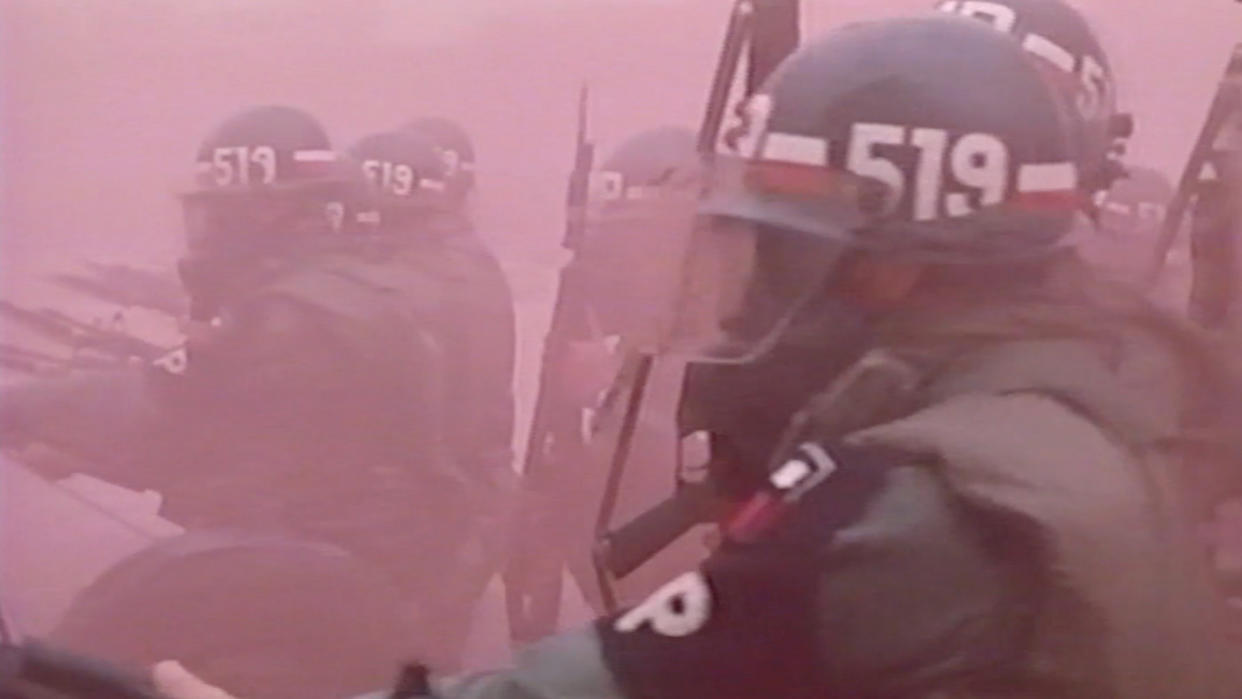‘Riotsville, USA’ Review: Sierra Pettengill’s Transfixing Doc Unveils the Ugly Truth of America’s Riot Police


. Relying exclusively on remarkable pre-existing footage, Pettengill tells the story of the development of the U.S. military’s riot management program in the late ’60s, formed in response to the civil rights uprisings in cities across the nation. The military held its riot training in these eponymous fake towns, constructed diorama-style to allow clean-cut soldiers to play-act as protesters, donning hippie clothing and long-haired wigs as they smashed the glass windows of make-believe businesses and overturned government-bought sedans.
Along with a star-studded group of collaborators, including the critic Tobi Haslett, who writes the keen and captivating running commentary, and masterful editor Nels Bangerter, who’s also worked with boundary-pushing documentarians Brett Storey and Kirsten Johnson, Pettengill periodically pokes and prods at this footage, zooming in to the point of pixelation or blurring the edges around figures to interrogate the meaning behind these moments. This unique framework succeeds in turning history on its head, forcing us to question how these violent tactics from the past have led to the increasingly armed present we’re witnessing today.
More from IndieWire
Most of Pettengill’s footage is presented unaltered, offering up a largely empirical study of this seemingly hopeful moment in time. What she gives us ends up looking like a post-mortem of something that went horribly wrong. The story begins with promise: in 1967, President Johnson establishes the National Advisory Commission on Civil Disorders, known as the Kerner Commission, after Otto Kerner, the Illinois governor at the helm. This politically moderate committee is set up in response to the escalating “disturbances” in cities like Watts, Detroit, and Newark, and in 1968 publishes a report outlining the causes of this widespread violence: systemic racism.
“Our nation is moving toward two societies, one Black, one white,” the report states. “Separate and unequal.” Their solutions are increased welfare, jobs, and housing — enormously expensive proposals that were far from any “quick fix” politicians had hoped for. The report flies off the shelves, making equality and justice seem like less of a pipe dream and more of a reality.
Through her rigorous archival investigation, Pettingill doesn’t leave any room for doubt: this actually happened, she seems to say. It wasn’t imagined. Her footage is culled solely from military recordings or broadcast television, and includes everything from Presidential speeches to political roundtables on community T.V. stations. One reporter sums up the political response to the proposed cost of implementing the report’s full list of recommendations: “They ask, ‘How can the president run one war with barely enough money to do it, … how can he now be expected to run a second war?’” As it turns out, the only advice that the government implements is an increase in funding for federal police.
This public gaslighting feels familiar, and to see it play out at this crucial time in history is disheartening, but not unexpected. Haslett eloquently elucidates the events: “A door swung open in the late ’60s. And someone, something, sprang up and slammed it shut.” Jace Klayton’s polyphonic electronic score also seems to brilliantly illustrate this stunted progress as it reverberates through the film. Notes topple on top of one another as if played by a slinky slowly falling down a flight of stairs: a series of fits and starts. The Kerner Commission brought about the revolution that could have been, one that was sadly deferred out of convenience. They got to the root of the problem and put a band-aid over it, the results of which we’re still experiencing today.
The bulk of this makeshift solution began in Riotsville. Lucky for Pettengill, and for us, the military was more than keen to record its staged uprisings, which were filmed in front of a live audience of officers. They laugh and applaud seemingly on-cue as the phony rabble-rousers are dragged out on buses and armored vehicles. To watch these military men pretend to be their supposed enemy, raising their fists and shouting “Hell no, we won’t go!” is visually confusing — while many of the young men are half-heartedly involved, some are so fervently invested that you continually have to remind yourself that it’s not real. To watch a Black soldier be violently manhandled, shouting “I’ll get you!” as he waves and points at his captors has a bizarre and disturbing verisimilitude to the images that one sees in reality.
These riot maneuvers were expected to be needed at the 1968 Democratic National Convention. The now-infamous police riot and the Chicago Seven trial are part of our national history, but Pettengill instead puts the focus on the earlier events of the Republican National Convention in Miami, which saw police use repurposed insect repellant trucks to spray tear gas in an effort to control crowds of protesters in Black neighborhoods.
“We’ve heard about Chicago, but we’ve been living through Miami Beach,” Haslett writes. The convention was sponsored by Gulf, which manufactured bug spray at the time. A Gulf commercial is ironically juxtaposed with this footage: “Swat It. Hit it. Get Mad. Or, kill it! … Gulf Spray contains more pyrethrins for more instant knock-out power.” It’s just one instance where Pettengill effortlessly connects the dots of hypocrisy in the government’s response to insurrection: instead of taking action to fight the cause of public unrest at its source, they’d prefer to squash out dissent like pesky insects, one after the next.
Grade: A-
“Riotsville, USA” premiered at the 2022 Sundance Film Festival. It is currently seeking U.S. distribution.
Best of IndieWire
New Movies: Release Calendar for January 21, Plus Where to Watch the Latest Films
'French Dispatch' and 'Last Night in Soho' Start to Lift Stagnant Specialty Box Office
Sign up for Indiewire's Newsletter. For the latest news, follow us on Facebook, Twitter, and Instagram.

